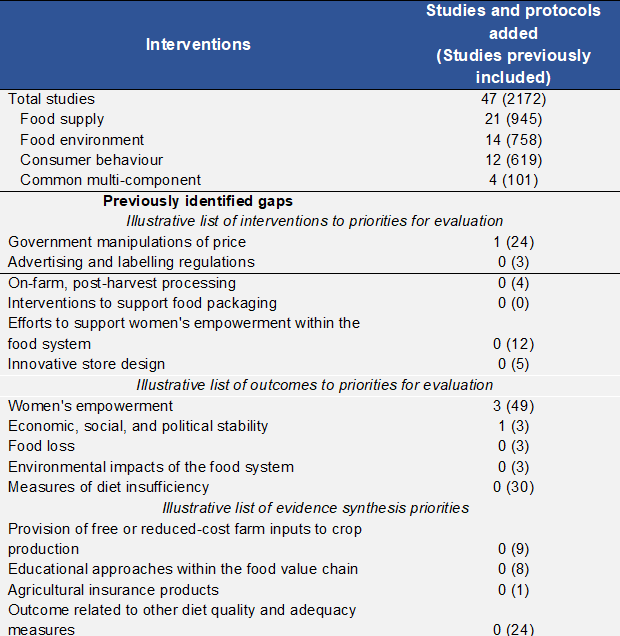In June 2022, a high-level expert group from the European Commission called for independent and up-to-date reports on the scientific evidence about food systems transformation. We certainly agree this work is essential – that’s why we’ve been producing such reports since 2020 as part of 3ie’s living Food Systems and Nutrition Evidence Gap Map (EGM). In our latest update, we add groundbreaking studies to the map, including one on sugar-sweetened beverage taxes.
Through the living EGM and our regular update briefs, we provide researchers and decision-makers with the most up to date evidence on food systems and nutrition, thanks to support from BMZ through the GIZ “Knowledge for Nutrition” (K4N) program. In the map, we present all impact evaluations and systematic reviews of interventions in low- and middle-income countries that function within food systems and measure outcomes related to food security and nutrition. We continuously monitor knowledge gaps in the evidence base to determine if the research focus is changing and whether identified evidence gaps have been addressed. New studies are made available through the interactive version of the EGM. The first two updates are available here and here. (Or if you prefer, those updates are discussed in blog posts here and here.)
We are now building a body of work around the living map in order to facilitate science-policy-practice interfaces and provide all stakeholders with the information they need to make evidence informed decisions. The findings of the original EGM were published in BMJ Open, and the last EGM update was presented at the Agriculture, Nutrition and Health (ANH) Academy conference. We leveraged the Food Systems and Nutrition EGM to conduct a rapid evidence assessment on women’s empowerment within food systems and a systematic review on fiscal policies to promote a healthy diet. These accelerated, systematic literature summaries directly responding to knowledge gaps identified through the EGM.
Update #3 fills key knowledge gaps
Our newest update showed researchers breaking new ground. One new study evaluated the impacts of sugar-sweetened beverage taxes on BMI in the Maldives. The tax had no effect on BMI. To date, no other study has considered the effects of such initiatives on BMI, the outcome they are meant to address. However, our recent systematic review identified evaluations of intermediate outcomes, such as purchasing behaviour and diet quality. The evidence on these outcomes was limited or inconclusive. We also identified the fourth-ever study to consider the effects of interventions within the food system on economic, social, and political stability. A beekeeping and entrepreneurship intervention in Tanzania reduced exposure to community violence and increased financial and social capital among young men.
We continued to see a meaningful shift towards quasi-experimental designs: a reduction from 80 percent in our original map to 63 percent in the newest update. This pattern might be explained by a shift away from over-studied, easy-to-randomize interventions, such as fortification and supplementation interventions. Innovative approaches are now increasingly used to measure interventions that cannot be randomized, such as national policies (n=6), market support (n=4), and agricultural savings and credit (n=3).
The living EGM – recent additions
- We added 47 studies to the map, taking the total to 2,219. Most of the new studies focused on the food supply chain (n=21), specifically the production system (n=20). There were 12 new studies related to each food environment and consumer behaviour. The most common outcomes were related to diet quality and adequacy and agriculture (n=18 each)
- There continues to be a reduction in the proportion of studies using randomization (now 63 per cent of studies). There were large increases in difficult to randomize areas with previously limited evidence bases:
- A 50 per cent increase in the evidence base on market support (four new studies added to the eight existing ones)
- A 16 per cent increase in the evidence base on agricultural savings and credit (three new studies added to the 19 existing ones).
- The shift away from randomization is now being reflected in a reduction in easy to randomize interventions, such as supplementation (n=3) and fortification (n=2). However, there continues to be a focus on the direct provision of food (n=8).
- Six studies evaluated national level policies, including the first study to evaluate the effects of a sugar-sweetened beverage tax on BMI.
Further information on additions to the Food Systems and Nutrition EGM can be found here. If you are interested, you can find other publications related to the map here and the map itself here.








